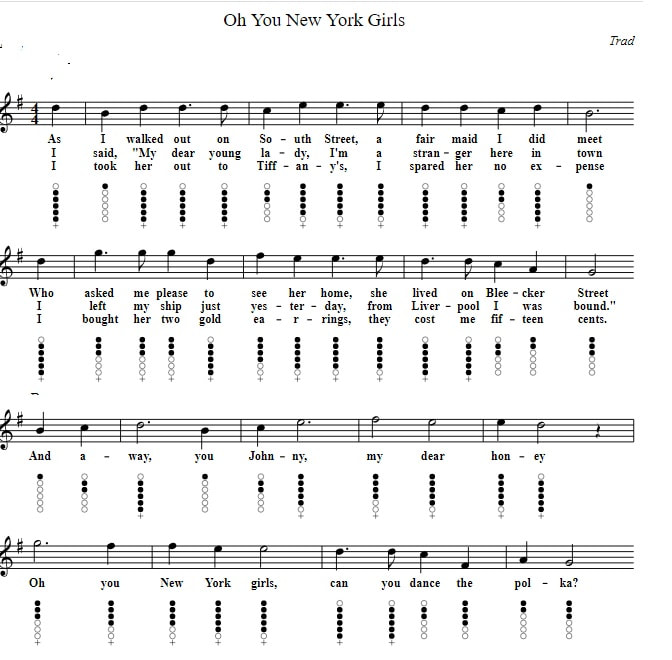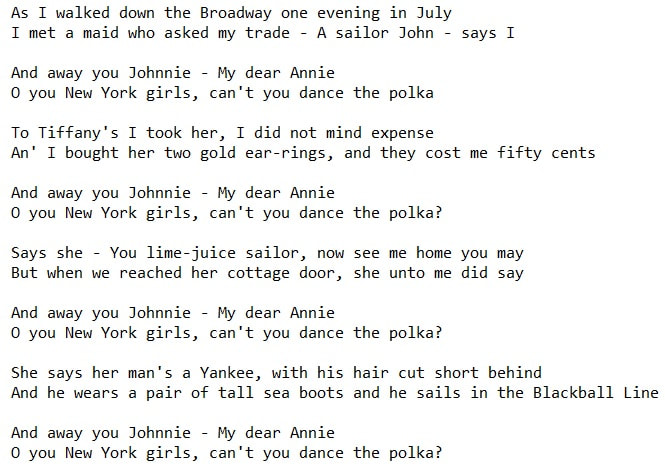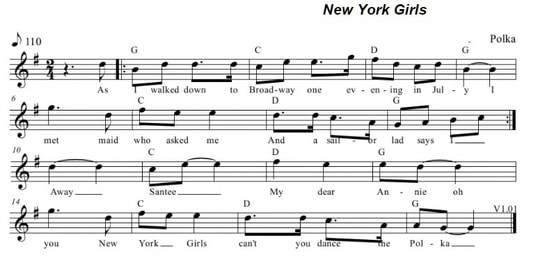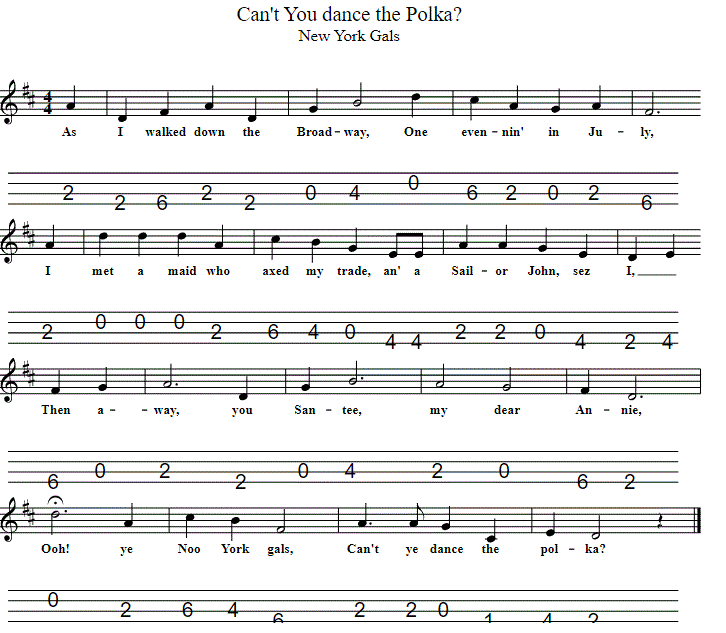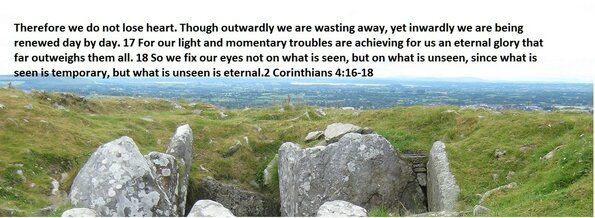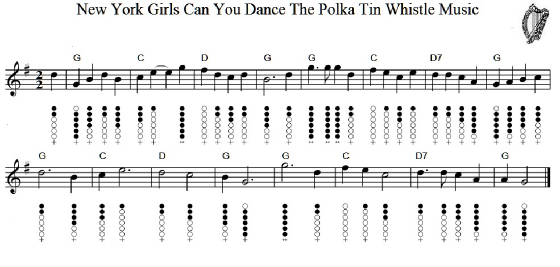New York Girls Can You Dance The Polka Lyrics And Chords
Irish Song Lyrics And Chords-Trad. Recorded by The Fureys with Finbar doing the singing. The tin whistle sheet music notes are included. Finbar sang this song in the key of E Major in the youtube video. The guitar chords are in Chordpro .New York girls can you dance the polka tenor guitar tab in CGDA. You can play the flute using the sheet music included plus a pdf of the piano sheet music.
Introduction:
Music is a universal language that transcends all barriers and connects people from different cultures and backgrounds. In the bustling city of New York, music has always been an integral part of its vibrant culture. The city is known for its diverse population and its rich history of art, literature, and music. Among the many genres of music that have flourished in New York, polka holds a special place. It is a lively and energetic dance form that has captured the hearts of New Yorkers, especially the girls. The song 'New York Girls Can You Dance The Polka' is a testament to this love affair between the city and the dance form. In this thesis, we will explore the history of polka in New York, its popularity among the girls, and the significance of the song in the context of the city's culture.
History of Polka in New York:
Polka originated in the 19th century in Bohemia, a central European region that is now part of the Czech Republic. It quickly gained popularity and spread across Europe, reaching the United States in the mid-19th century. New York, being a melting pot of different cultures, embraced polka with open arms. It became a staple in the city's social events, especially among the immigrant communities. The energetic and lively nature of polka made it a popular choice for celebrations and gatherings.
The dance form evolved over the years and incorporated elements from other cultures, such as the Irish jig and the Italian tarantella. In New York, polka was also influenced by the city's jazz scene, resulting in a unique fusion of styles. The dance form became a symbol of the city's diversity, bringing people from different backgrounds together on the dance floor.
Popularity among Girls:
While polka was popular among both men and women, it gained a special following among the girls of New York. The dance form allowed them to express themselves freely and let loose in a society that often restricted their movements. Polka was seen as a form of rebellion for women, as it challenged traditional gender roles and allowed them to take the lead on the dance floor. It also provided a sense of empowerment and confidence to the girls, who found joy in mastering the intricate steps of the dance.
Moreover, polka was also a social activity for girls, allowing them to bond with their friends and make new connections. It was not just about the dance but also about the community and camaraderie it fostered. This was especially significant for immigrant girls, who found a sense of belonging and acceptance in the polka community.
Significance of the Song:
The song 'New York Girls Can You Dance The Polka' is a celebration of the city's love for polka and its girls. It was composed in the 1920s by American musician and composer, Irving Berlin. The lyrics of the song capture the essence of polka and its place in the city's culture. It speaks of the energy, joy, and freedom that the dance brings to the girls of New York. The song also highlights the city's diversity by mentioning different nationalities who all come together to dance the polka.
Over the years, the song has become an anthem for polka lovers in New York. It is often played at polka events and has become a symbol of the city's rich cultural heritage. The song continues to be popular among girls, who proudly dance to its catchy tune and celebrate their love for polka.
Conclusion:
In conclusion, 'New York Girls Can You Dance The Polka' is more than just a song. It is a representation of the city's vibrant culture, the evolution of polka, and the strong bond between the dance form and its female dancers. The song has stood the test of time and continues to be a beloved piece of music in New York. It reminds us of the power of music to bring people together and celebrates the spirit of the city and its girls.
Music is a universal language that transcends all barriers and connects people from different cultures and backgrounds. In the bustling city of New York, music has always been an integral part of its vibrant culture. The city is known for its diverse population and its rich history of art, literature, and music. Among the many genres of music that have flourished in New York, polka holds a special place. It is a lively and energetic dance form that has captured the hearts of New Yorkers, especially the girls. The song 'New York Girls Can You Dance The Polka' is a testament to this love affair between the city and the dance form. In this thesis, we will explore the history of polka in New York, its popularity among the girls, and the significance of the song in the context of the city's culture.
History of Polka in New York:
Polka originated in the 19th century in Bohemia, a central European region that is now part of the Czech Republic. It quickly gained popularity and spread across Europe, reaching the United States in the mid-19th century. New York, being a melting pot of different cultures, embraced polka with open arms. It became a staple in the city's social events, especially among the immigrant communities. The energetic and lively nature of polka made it a popular choice for celebrations and gatherings.
The dance form evolved over the years and incorporated elements from other cultures, such as the Irish jig and the Italian tarantella. In New York, polka was also influenced by the city's jazz scene, resulting in a unique fusion of styles. The dance form became a symbol of the city's diversity, bringing people from different backgrounds together on the dance floor.
Popularity among Girls:
While polka was popular among both men and women, it gained a special following among the girls of New York. The dance form allowed them to express themselves freely and let loose in a society that often restricted their movements. Polka was seen as a form of rebellion for women, as it challenged traditional gender roles and allowed them to take the lead on the dance floor. It also provided a sense of empowerment and confidence to the girls, who found joy in mastering the intricate steps of the dance.
Moreover, polka was also a social activity for girls, allowing them to bond with their friends and make new connections. It was not just about the dance but also about the community and camaraderie it fostered. This was especially significant for immigrant girls, who found a sense of belonging and acceptance in the polka community.
Significance of the Song:
The song 'New York Girls Can You Dance The Polka' is a celebration of the city's love for polka and its girls. It was composed in the 1920s by American musician and composer, Irving Berlin. The lyrics of the song capture the essence of polka and its place in the city's culture. It speaks of the energy, joy, and freedom that the dance brings to the girls of New York. The song also highlights the city's diversity by mentioning different nationalities who all come together to dance the polka.
Over the years, the song has become an anthem for polka lovers in New York. It is often played at polka events and has become a symbol of the city's rich cultural heritage. The song continues to be popular among girls, who proudly dance to its catchy tune and celebrate their love for polka.
Conclusion:
In conclusion, 'New York Girls Can You Dance The Polka' is more than just a song. It is a representation of the city's vibrant culture, the evolution of polka, and the strong bond between the dance form and its female dancers. The song has stood the test of time and continues to be a beloved piece of music in New York. It reminds us of the power of music to bring people together and celebrates the spirit of the city and its girls.
[G]As I walked down the[C] Broadway one[D] evening in Ju[G]ly
I met a maid who[C] asked my trade – A [D7]sailor John - says[G] I
[G]And away you[C] Johnnie – My[D] dear[G] Annie
O you[C] New York girls,[D7] can't you dance the[G] polka
To Tiffany's I took her, I did not mind expense
An' I bought her two gold ear-rings, and they cost me fifty cents
And away you Johnnie – My dear Annie
O you New York girls, can't you dance the polka?
Says she - You lime-juice sailor, now see me home you may
But when we reached her cottage door, she unto me did say
And away you Johnnie – My dear Annie
O you New York girls, can't you dance the polka?
She says her man's a Yankee, with his hair cut short behind
And he wears a pair of tall sea boots and he sails in the Blackball Line
And away you Johnnie – My dear Annie
O you New York girls, can't you dance the polka?
I met a maid who[C] asked my trade – A [D7]sailor John - says[G] I
[G]And away you[C] Johnnie – My[D] dear[G] Annie
O you[C] New York girls,[D7] can't you dance the[G] polka
To Tiffany's I took her, I did not mind expense
An' I bought her two gold ear-rings, and they cost me fifty cents
And away you Johnnie – My dear Annie
O you New York girls, can't you dance the polka?
Says she - You lime-juice sailor, now see me home you may
But when we reached her cottage door, she unto me did say
And away you Johnnie – My dear Annie
O you New York girls, can't you dance the polka?
She says her man's a Yankee, with his hair cut short behind
And he wears a pair of tall sea boots and he sails in the Blackball Line
And away you Johnnie – My dear Annie
O you New York girls, can't you dance the polka?
Here are the guitar chords for the Finbar Furey version in the youtube video.
[E]As I walked down through Chatham Street a [E]fair maid I did [A]meet
She asked me to [D]see her home she [E]lived in Bleeker [A]Street
[A]And away [D]Santy – [E]My dear[A] Annie
O you[D] New York girls,[E] can't you dance the[A] polka.
Lyrics And Chords list N-R
[E]As I walked down through Chatham Street a [E]fair maid I did [A]meet
She asked me to [D]see her home she [E]lived in Bleeker [A]Street
[A]And away [D]Santy – [E]My dear[A] Annie
O you[D] New York girls,[E] can't you dance the[A] polka.
Lyrics And Chords list N-R
New York Girls Can You Dance The Polka Sheet / Flute Music In The Key Of G Major
| new-york-girls-piano-sheet-music-pdf.pdf |
New york girls can you dance the polka tenor guitar tab in CGDA

